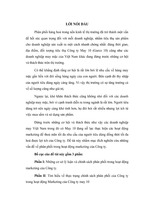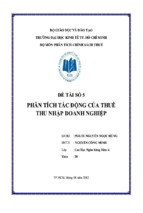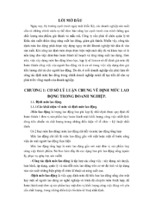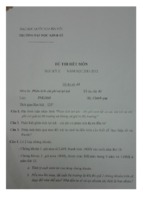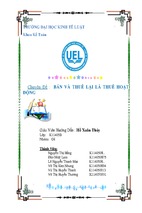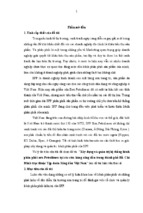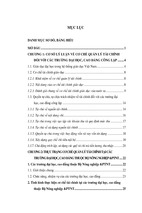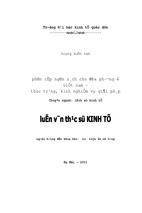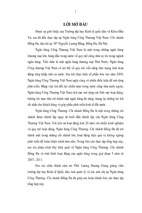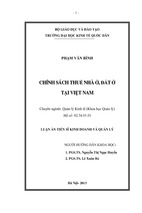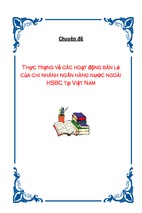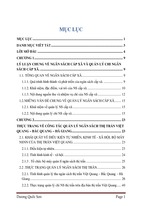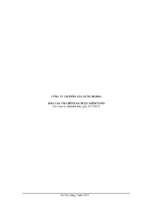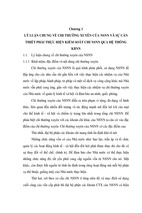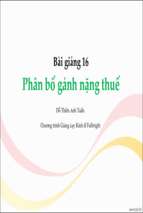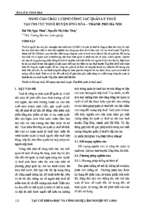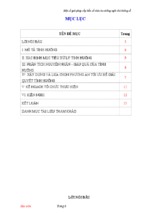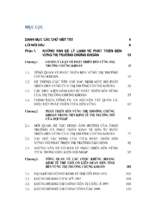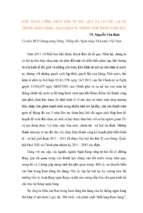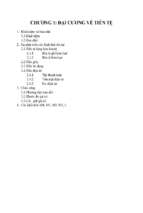Coding Schemes for the Two-Way Relay
Channels
Peng Zhong
Department of Electrical & Computer Engineering
McGill University
Montreal, Canada
August 2012
A thesis submitted to McGill University in partial fulfillment of the requirements for the
degree of Master of Engineering.
c 2012 Peng Zhong
i
Abstract
In modern transmission networks, relay plays an important role for cooperative strategies.
Several relaying strategies, such as decode-forward, compress-forward and amplify-forward,
have been proposed for relay channels and networks. However, the capacity for the general
relay channel and network is still unknown. In this thesis, we propose several relay schemes
for different relay models.
In the first part of the thesis, we propose novel partial decode-forward (PDF) schemes
for the two-way relay channel with direct link. Different from pure decode-forward, each
user divides its message into two parts and the relay decodes only one part of each. The
relay then generates its codeword as a function of the two decoded parts and forwards to
the two users. We propose PDF schemes for both the full- and half-duplex modes. Analysis
and simulation show that if for one user, the direct link is stronger than the user-to-relay
link, while for the other, the direct link is weaker, then PDF can achieve a rate region
strictly larger than the time-shared region of pure decode-forward and direct transmission
for both full- and half-duplex modes.
The second part of the thesis is based on noisy network coding, which is recently proposed for the general multi-source network by Lim, Kim, El Gamal and Chung. This
scheme builds on compress-forward (CF) relaying but involves three new ideas, namely no
Wyner-Ziv binning, relaxed simultaneous decoding and message repetition. In this part,
using the one-way and two-way relay channel as the underlining example, we analyze the
impact of each of these ideas on the achievable rate region of relay networks.
In the third part of the thesis, we propose two coding schemes combining decode-forward
(DF) and noisy network coding (NNC) with different flavors. The first is a combined DFNNC scheme for the one-way relay channel which includes both DF and NNC as special
cases by performing rate splitting, partial block Markov encoding and NNC. The second
combines two different DF strategies and layered NNC for the two-way relay channel.
Analysis and simulation show that both proposed schemes supersede each individual scheme
and take full advantage of both DF and NNC.
ii
Abrégé
Dans les réseaux de transmission modernes, les relais jouent un rôle important dans les
stratégies coopératives. Plusieurs stratégies de relai, telles que decode-forward, compressforward et amplify-forward, ont été proposées pour les canaux et réseaux à relais. Cependant, la capacité du canal à relai général et de tels réseaux reste toujours inconnue. Dans
cette thèse, nous proposons plusieurs stratégies de relai pour différents modèles.
Dans un premier temps, nous proposons de nouvelles stratégies de decode-forward partiel (PDF) pour le canal à relai bidirectionnel avec lien direct. A la différence du decodeforward classique, chaque utilisateur divise son message en deux parties, mais le relai ne
décode que l’une d’entre elles pour chacun. Le relai génère alors un mot de code en fonction de ces deux parties décodées et les transmet aux deux utilisateurs. Nous proposons
une stratgie PDF à la fois pour les liaisons half- et full-duplex. Comme le montrent les
analyses et simulations réalisées, si, pour l’un des utilisateurs, le lien direct est meilleur que
le lien utilisateur-relai alors que, pour l’autre utilisateur, le lien direct est plus faible, dans
ce cas, la stratégie PDF permet d’accroı̂tre strictement la région des débits atteignables
par rapport à la région atteinte par le partage de temps avec la stratégie decode-forward
classique et la transmission directe, à la fois pour les liaisons half- et full-duplex.
La deuxième partie de cette thèse s’intéresse au codage de réseau avec bruit, qui a été
abordé récemment pour les réseaux multi-sources génériques par Lim, Kim, El Gamal et
Chung. Cette stratégie se base sur le relayage par compress-forward (CF), mais utilise trois
nouvelles idées, à savoir le binning de Wyner-Ziv, le décodage simultané moins contraignant
et la répétition de message. Dans cette partie, nous prenons pour exemple les canaux à
relai mono- et bidirectionnels, et nous analysons l’impact de chacune de ces idées sur la
région des débits atteignables pour les réseaux à relais.
Dans la troisième partie de cette thèse, nous proposons deux stratégies de codage qui
combinent le decode-forward (DF) et le codage de réseau avec bruit (NNC), avec différentes
nuances. La première est une stratégie combinée DF-NNC pour le canal à relai monodirectionnel, pour laquelle DF et NNC représentent des cas particuliers par partage de débit,
de même que lencodage partiel en bloc de Markov et NNC. La deuxième stratégie combine
deux stratégies DF différentes au codage NNC en couches pour le canal à relai bidirectionnel. Les analyses et les simulations montrent que les deux stratégies proposées remplacent
chaque stratégie individuelle et prennent pleinement avantage des stratégies DF et NNC.
iii
Acknowledgments
Foremost, I would like to express my gratitude to my supervisor, Prof. Mai Vu. She gave
me the opportunity to join her lab and work with her. Over the past two years, I have
gained a deep respect for Mai’s attitudes and principles about research. She taught me
how to do research and how to dig into a problem. Her comments and feedback on my
research work benefited me a lot. Without her patient guidance and support, this thesis
would have never been written.
I would also like to thank my lab members, including Ahmad, Fanny, Zhuohua, Yao
and Jun. Special thanks to Ahmad for his help in my “multiuser communication” course.
As course teaching assistant, he always showed enough patience in solving our problems
and teaching us many useful methods. I also enjoyed discussing research problems with
Zhuohua. Also, thanks for his help in some administrative issues. It has been a great
pleasure to work with him. Special thanks go to Fanny for translating the abstract into
French.
I am very lucky to meet so many friends at McGill. They helped me a lot with my
study and life. It is hard to imagine life at McGill without them. Special thanks to my
roommate Xiaofan. He shared his thoughts about his research to me. It helps me to learn
a lot of new concepts outside my field. Also, thanks Nancy for proof checking my English
writing.
Finally, I would like to express my endless gratitude to my family. My parents instilled
a passion for science in me when I was still young. They spare no effort to support me
studying abroad. Without their love and support, I would never have been able to study
at McGill.
iv
v
Contents
1 Introduction
1.1 Background . . . . . . . . . . . . . . . . . . . . . . . . . . . . . . . . . . .
1.2 Literature Review . . . . . . . . . . . . . . . . . . . . . . . . . . . . . . . .
1.3 Outline and Contributions . . . . . . . . . . . . . . . . . . . . . . . . . . .
1
1
2
8
2 Channel Models
2.1 One-Way Relay Channel Model . . . . . . . . . . . . . . . . . . . . . . . .
2.2 Two-Way Relay Channel Model . . . . . . . . . . . . . . . . . . . . . . . .
2.3 Relay Networks Model . . . . . . . . . . . . . . . . . . . . . . . . . . . . .
13
13
14
17
3 Partial Decode-Forward Coding Schemes
3.1 Problem Statement . . . . . . . . . . . . . . . . . . . . . . . . . . . . . . .
3.2 Partial DF for Full-Duplex TWRC . . . . . . . . . . . . . . . . . . . . . .
3.3 Partial DF for Half-Duplex TWRC . . . . . . . . . . . . . . . . . . . . . .
19
19
20
26
4 Compress-Forward Without Binning
4.1 Problem Statement . . . . . . . . . .
4.2 One-Way Relay Channel . . . . . . .
4.3 Two-Way Relay Channel . . . . . . .
4.4 Implication for Relay Networks . . .
4.5 Gaussian Two-Way Relay Channel .
.
.
.
.
.
33
33
34
37
43
52
5 Combined Decode-Forward and Layered Noisy Network Coding
5.1 Problem Statement . . . . . . . . . . . . . . . . . . . . . . . . . . . . . . .
5.2 Combined DF and NNC Scheme for the One-Way Relay Channel . . . . .
61
61
62
.
.
.
.
.
.
.
.
.
.
.
.
.
.
.
.
.
.
.
.
.
.
.
.
.
.
.
.
.
.
.
.
.
.
.
.
.
.
.
.
.
.
.
.
.
.
.
.
.
.
.
.
.
.
.
.
.
.
.
.
.
.
.
.
.
.
.
.
.
.
.
.
.
.
.
.
.
.
.
.
.
.
.
.
.
.
.
.
.
.
.
.
.
.
.
.
.
.
.
.
vi
Contents
5.3
5.4
Combined DF and LNNC for the Two-Way Relay Channel . . . . . . . . .
Numerical Results . . . . . . . . . . . . . . . . . . . . . . . . . . . . . . . .
66
72
6 Conclusion and Future Work
6.1 Conclusion . . . . . . . . . . . . . . . . . . . . . . . . . . . . . . . . . . . .
6.2 Future Work . . . . . . . . . . . . . . . . . . . . . . . . . . . . . . . . . . .
75
75
76
A Proofs
A.1 Proof of Theorem 4 . . . . . . . . . .
A.2 Proof of Theorem 6 . . . . . . . . . .
A.3 Proof of Theorem 8 . . . . . . . . . .
A.4 Proof of Theorem 9 . . . . . . . . . .
A.5 Proof of Corollary 1 . . . . . . . . . .
A.6 Proof of Corollary 2 . . . . . . . . . .
A.7 Proofs of Corollary 5 and Corollary 6
77
77
81
85
88
90
92
95
References
.
.
.
.
.
.
.
.
.
.
.
.
.
.
.
.
.
.
.
.
.
.
.
.
.
.
.
.
.
.
.
.
.
.
.
.
.
.
.
.
.
.
.
.
.
.
.
.
.
.
.
.
.
.
.
.
.
.
.
.
.
.
.
.
.
.
.
.
.
.
.
.
.
.
.
.
.
.
.
.
.
.
.
.
.
.
.
.
.
.
.
.
.
.
.
.
.
.
.
.
.
.
.
.
.
.
.
.
.
.
.
.
.
.
.
.
.
.
.
.
.
.
.
.
.
.
.
.
.
.
.
.
.
.
.
.
.
.
.
.
.
.
.
.
.
.
.
99
vii
List of Figures
2.1
2.2
2.3
2.4
2.5
2.6
Discrete memoryless one-way relay channel model. .
Gaussian one-way relay channel model. . . . . . . .
Discrete memoryless two-way relay channel model. .
Full-duplex Gaussian two-way relay channel model.
Half-duplex Gaussian two-way relay channel model.
Relay network model. . . . . . . . . . . . . . . . . .
3.1
Partial decode-forward achieves rates outside the time-shared region of decodeforward and direct transmission in the full-duplex TWRC. . . . . . . . . .
Partial decode-forward achieves time-shared region of decode-forward and
direct transmission in the full-duplex TWRC. . . . . . . . . . . . . . . . .
Half-duplex partial decode-forward transmission diagram. . . . . . . . . . .
Rate region comparison between partial decode-forward, pure decode-forward
and direct transmission for the half-duplex Gaussian TWRC. . . . . . . . .
30
4.1
4.2
4.3
Rate regions for P = 20, gr1 = g1r = 2, gr2 = g2r = 0.5, g12 = g21 = 0.1. . . .
Rate regions for P = 20, gr1 = 0.5, g1r = 2, gr2 = 2, g2r = 0.5, g12 = g21 = 0.1.
Sum rate for gr1 = g1r = 2, gr2 = g2r = 0.5, g12 = g21 = 0.1. . . . . . . . . .
55
56
58
5.1
Achievable rate comparison for the one-way relay channel with P = 10, g1 =
d−γ/2 , g2 = (1 − d)−γ/2 , g = 1, γ = 3. . . . . . . . . . . . . . . . . . . . . . .
Sum rate for the two-way relay channel with P = 10, gr1 = g1r = d−γ/2 , gr2 =
g2r = (1 − d)−γ/2 , g12 = g21 = 1, γ = 3. . . . . . . . . . . . . . . . . . . . . .
Achievable rate region comparison for the two-way relay channel with P =
3, gr1 = 6, g1r = 2, gr2 = 2, g2r = 3, g12 = 1, g21 = 0.5. . . . . . . . . . . . . .
3.2
3.3
3.4
5.2
5.3
.
.
.
.
.
.
.
.
.
.
.
.
.
.
.
.
.
.
.
.
.
.
.
.
.
.
.
.
.
.
.
.
.
.
.
.
.
.
.
.
.
.
.
.
.
.
.
.
.
.
.
.
.
.
.
.
.
.
.
.
.
.
.
.
.
.
.
.
.
.
.
.
.
.
.
.
.
.
13
14
15
16
16
17
25
26
27
72
73
74
viii
List of Figures
A.1 Example for case 1. . . . . . . . . . . . . . . . . . . . . . . . . . . . . . . .
A.2 Example for case 2. . . . . . . . . . . . . . . . . . . . . . . . . . . . . . . .
78
79
ix
List of Tables
4.1
4.2
4.3
Encoding and decoding of CF without binning
Encoding and decoding of CF without binning
Encoding and decoding of CF without binning
etition for the two-way relay channel. . . . . .
for the one-way relay channel. 34
for the two-way relay channel. 38
but with twice message rep. . . . . . . . . . . . . . . .
49
5.1
Comparison of achievable rates for P1 = 5, P2 = 1 . . . . . . . . . . . . . .
73
x
List of Acronyms
DF
CF
HF
EHF
PDF
RC
TWRC
NNC
LNNC
MARC
BRC
SNR
AWGN
DM
Decode-Forward
Compress-Forward
Hash-Forward
Extended Hash-Forward
Partial Decode-Forward
Relay Channel
Two-Way Relay Channel
Noisy Network Coding
Layered Noisy Network Coding
Multiple Access Relay Channel
Broadcase Relay Channel
Signal-to-Noise Ratio
Additive White Gaussian Noise
Discrete meroryless
1
Chapter 1
Introduction
1.1 Background
With the increasing size of communication networks, cooperative transmission is becoming
more and more important. For example, in a wireless network, the transmitted message
from a node is heard not only by its intended receiver, but also by other neighbour nodes.
Those neighbour nodes can use the received signals to help transmission. They bring a
cooperative transmission by acting as relays.
The relay channel (RC) first introduced by van der Meulen consists of a source aiming to
communicate with a destination with the help of a relay (called single relay channel or oneway relay channel). In [1], Cover and El Gamal propose the fundamental decode-forward
(DF), compress-forward (CF) schemes for the one-way relay channel. In DF, the relay
decodes the message from the source and forwards it to the destination. In CF, the relay
compresses received signal and forwards the compression index. Although a combination
of these schemes achieve capacity of several types of channels, none of them are optimal in
general. We will discuss more details in the literature review section.
The one-way relay channel can be extended to the two-way relay channel (TWRC) in
which a relay helps two users exchange messages. Two types of TWRC exist: one without
a direct link between the two users, a model suitable for wired communication, and one
with the direct link, more suitable for wireless communication. In this thesis, we focus on
the TWRC with direct link between the two users, also called the full TWRC. TWRC is
a practical channel model for wireless communication systems. For example, a dedicated
relay station has been proposed in 4G wireless standards to help the mobile and base station
2
Introduction
exchange messages. The decode-forward and compress-forward schemes can be generalized
to the two-way relay channel, such as in [2] and [3].
More generally, relay channels can be extended to relay networks, in which each node
wishes to send a message to some destinations while also acting as a relay for others. In [4],
decode-forward and compress-forward are studied in relay networks. In [5], Lim, Kim, El
Gamal and Chung propose a noisy network coding scheme based on compress-forward for
the general relay network. More details on those works will be discussed in literature review
section.
Although relay channels and networks have drawn growing attention, the capacity region
of relay network is still unknown. What is the optimal coding scheme that achieves the
capacity region? In this thesis, we propose and analyze several coding schemes for the relay
channels. These schemes are steps towards understanding the optimal coding.
1.2 Literature Review
A number of coding schemes have been proposed for relay channels and networks. Some
basic relaying strategies include amplify-forward, decode-forward and compress-forward. In
this section, we will first review works on decode-forward and compress-forward. Most of
our works in this thesis are based on these two schemes. After that, we will briefly review
a new relaying strategy called compute-forward.
Before our literature review, we introduce two transmission modes: full-duplex transmission and half-duplex transmission. In full-duplex transmission, each node can transmit
and receive at the same time; whereas for half-duplex transmission, each node can only
either transmit or receive at each time. In this section, unless otherwise specified, the
transmission mode is full-duplex.
1.2.1 Decode-Forward
In this part, we review related works on decode-forward for relay channels and relay networks. We divide the discussion into two parts. The first part is on single-source, single
destination relay networks. The second part is on multi-source, multi-destination relay
networks such as the two-way relay channel.
1.2 Literature Review
3
Single-source single destination relay networks
• In [1], Cover and El Gamal propose a decode-forward scheme for the one-way relay
channel. The source uses block Markov superposition encoding. The relay decodes
the message and sends its random binning index. The destination performs successive
decoding. The following rate is achievable with DF:
R ≤ min{I(X, Xr ; Y ), I(X; Yr |Xr )}
(1.1)
for some p(x, xr ). They also propose a partial decode-forward scheme in which the
message is split into two parts, and the relay only decodes one part of them. It
achieves the same rate either as decode or as direct transmission (without using the
relay) for the Gaussian channel.
• In [6], Willems and van der Meulen introduces a backward decoding in which decoding
at the receiver is done backwards after all blocks are received. It achieves the same
rates as that in [1] for the discrete memoryless channel.
Multi-source multi-destination relay networks
• In [2], Rankov and Wittneben apply decode-forward to the two-way relay channel.
In their proposed DF scheme, the two users perform partial block Markov encoding,
and the relay sends a superposition of the codewords for the two decoded messages
in each block.
• A different DF strategy is proposed in [3] by Xie, in which the users encode independently with the relay without block Markovity, and the relay sends a codeword for
the random binning of the two decoded messages. These two DF schemes [2] [3] do
not include each other in general.
• In [4], Kramer, Gastpar and Gupta extend decode-forward to several classes of relay
networks, including single-source, single-destination, multi-relay network, multiple
access relay channel (MARC) and broadcast relay channel (BRC). Sliding-window
decoding is performed at the destinations.
• Decode-forward has also been applied to the half-duplex two-way relay channel. In [7],
three full decode-forward protocols are proposed which has 2, 3 or 4 phases, in which
4
Introduction
the 4-phase protocol contains the 2- and 3-phase ones as special cases and achieves
the largest rate region. In [8], these authors extend the protocols to a mixed relaying
strategy which combines CF in one direction and DF in the other.
1.2.2 Compress-Forward
In this part, we review related works on compress-forward (CF) strategies for relay channels
and networks. We divide the discussion into three parts. The first part is on single-source,
single-destination relay networks. The second part is on some variants of the CF scheme.
The third part is on multi-source multi-destination relay networks.
Single-source single-destination relay networks
In the following works, the source and relay encoding are similar. At each block, the source
sends a different message; the relay first compresses its received signal then uses Wyner-Ziv
binning to reduce the forwarding rate. The differences are mainly in the decoding at the
destination by either performing successive or joint decoding.
• Compress-forward is originally proposed for the 3-node single-relay channel (also
called the one-way relay channel) by Cover and El Gamal in [1]. The source sends a
new message at each block using independent codebooks. The relay compresses its
noisy observation of the source signal and forwards the bin index of the compression
to the destination using Wyner-Ziv coding [9]. A 3-step sequential decoding is then
performed at the destination. At the end of each block, the destination first decodes
the bin index, and then decodes the compression index within that bin, and at last
uses this compression index to decode the message sent in the previous block. The
following rate is achievable with the 3-step sequential decoding CF scheme:
R ≤ I(X; Y, Ŷr |Xr )
subject to
I(Xr ; Y ) ≥ I(Ŷr ; Yr |Xr , Y ).
for some p(x)p(xr )p(ŷr |yr , xr )p(y, yr |x, xr ).
(1.2)
1.2 Literature Review
5
• El Gamal, Mohseni, and Zahedi put forward a 2-step decoding CF scheme in [10].
The source and relay perform the same encoding as that in [1]. The destination,
however, decodes in 2 sequential steps. At the end of each block, it decodes the bin
index first, and then decodes the message for some compression indices within that
bin instead of decoding the compression index precisely. With this 2-step decoding
CF scheme, the following rate is achievable:
R ≤ min{I(X, Xr ; Y ) − I(Ŷr ; Yr |X, Xr , Y ), I(X; Y, Ŷr |Xr )}
(1.3)
for some p(x)p(xr )p(ŷr |yr , xr )p(y, yr |x, xr ). It has been shown [10] [11] that this 2-step
decoding CF achieves the same rate as the original 3-step decoding CF in (1.2) but
has a simpler representation.
• Kramer, Gastpar, and Gupta extend the 3-step decoding CF scheme to the singlesource, single-destination and multiple-relay network in [4]. The relays can also cooperate with each other to transmit the compression bin indices by partially decoding
these bin indices.
• Chong, Motani and Garg propose two coding schemes for the one-way relay channel combining decode-forward and compress-forward in [12]. Similar to the original
combined scheme in [1], the source splits its message into two parts and the relay
decode-forwards one part and compress-forwards the other. The destination, however, performs backward decoding either successively or simultaneously. These two
strategies achieve higher rates than the original combined strategy in [1] for certain
parameters of the Gaussian relay channel.
Variants of compress-forward
Several variants of the CF scheme have been proposed for the relay channel.
• Cover and Kim propose a hash-forward (HF) scheme for the deterministic relay channel in [13], in which the relay hashes (randomly bins) its observation directly without
compression and forwards the bin index to the destination. HF achieves the capacity of the deterministic relay channel. Kim then proposes an extended hash-forward
(EHF) scheme in [14] which allows the destination to perform list decoding of the
source messages for the general non-deterministic case.
6
Introduction
• Razaghi and Yu introduce in [15] a generalized hash-forward (GHF) relay strategy
which allows the relay to choose a description of a general form rather than direct
hashing (binning) of its received signal, but with a description rate on the opposite
regime of Wyner-Ziv binning. The destination then performs list decoding of the
description indices. GHF achieves the same rate as the original CF for the oneway relay channel but have been shown to exhibit advantage for multi-destination
networks by allowing different description rates to different destinations [16].
• Recently a new notion of quantize-forward or CF without binning emerges [5] [17]
in which the relay compresses its received signal but forwards the compression index
directly without using Wyner-Ziv binning. We discuss this idea in more details in
the next few paragraphs.
Multi-source multi-destination relay networks
Relatively fewer works have applied CF to the general multi-source multi-destination relay
network.
• Rankov and Wittneben applied the 3-step decoding CF scheme to the two-way relay
channel (TWRC) in [2], in which two users wish to exchange messages with the help
of a relay. The encoding and decoding are similar to those in [1].
• Recently, Lim, Kim, El Gamal and Chung put forward a noisy network coding scheme
[5] for the general multi-source noisy network. This scheme involves three key new
ideas. The first is message repetition, in which the same message is sent multiple
times over consecutive blocks using independent codebooks. Second, each relay does
not use Wyner-Ziv binning but only compresses its received signal and forwards the
compression index directly. Third, each destination performs simultaneous decoding
of the message based on signals received from all blocks without uniquely decoding
the compression indices. Noisy network coding simplifies to the capacity-achieving
network coding for the noiseless multicast network. Compared to the original CF, it
achieves the same rate for the one-way relay channel and achieves a larger rate region
when applied to multi-source networks such as the two-way relay channel. However,
it also brings more delay in decoding because of message repetition.
1.2 Literature Review
7
• In [18], Lim, Kim, El Gamal and Chung propose an improved NNC scheme termed
”layered noisy network coding” (LNNC). The relay compresses its observation into
two layers: one is used at both destinations, while the other is only used at one
destination.
• In [19], Ramalingam and Wang propose a superposition NNC scheme for restricted
relay networks, in which source nodes cannot act as relays, by combining decodeforward and noisy network coding and show some performance improvement over
NNC. Their scheme, however, does not include DF relaying rate because of no block
Markov encoding.
Analysis of compress-forward schemes
With the above variants and developments on CF relaying, some works have analyzed the
different ideas in compress-forward.
• Kim, Skoglund and Caire [20] show that without Wyner-Ziv binning at the relay,
using sequential decoding at the destination incurs rate loss in the one-way relay
channel. The amount of rate loss is quantified specifically in terms of the diversitymultiplexing tradeoff for the fading channel.
• Wu and Xie demonstrate in [21] that for single-source, single-destination and multiplerelay networks, using the original CF encoding with Wyner-Ziv binning of [1], there
is no improvement on the achievable rate by joint decoding of the message and compression indices. To maximize the CF achievable rate, the compression rate should
always be chosen to support successive decoding.
• Wu and Xie then propose in [22] for the single-source, single-destination and multiplerelay network a scheme that achieves the same rate as noisy network coding [5] but
with the simpler classical encoding of [1] and backward decoding. The backward
decoding involves first decoding the compression indices then successively decoding
the messages backward. It requires, however, extending the relay forwarding times
for a number of blocks without sending new messages, which causes an albeit small
but non-vanishing rate loss.
8
Introduction
• Kramer and Hou discuss in [17] a short-message quantize-forward scheme without
message repetition or Wyner-Ziv binning but with joint decoding of the message and
compression index at the destination. It also achieves the same rate as the original
CF and noisy network coding for the one-way relay channel.
• Recently, Hou and Kramer in [23] propose a short message noisy network coding for
multiple sources relay network. It transmits independent short messages in blocks
rather than using long message repetitive encoding and uses backward decoding. It
is shown to achieve the same rates as noisy network coding.
1.2.3 Compute-Forward
A new relaying strategy called compute-forward was recently proposed in [24], in which
the relay decodes linear functions of transmitted messages. Nested lattice code [25] is
used to implement compute-forward in Gaussian channels, since it ensures the sum of two
codewords is still a codeword. Compute-forward has been shown to outperforms DF in
moderate SNR regimes but is worse at low or high SNR [24]. Compute-forward can be
naturally applied in two-way relay channels as the relay now receives signal containing
more than one message. In [26], nested lattice codes were proposed for the Gaussian
separated TWRC with symmetric channel, i.e. all source and relay nodes have the same
transmit powers and noise variances. For the more general separated AWGN TWRC case,
compute-forward coding with nested lattice code can achievable rate region within 1/2
bit of the cut-set outer bound [27] [28]. For the full AWGN TWRC, a scheme based on
compute-forward, list decoding and random binning technique is proposed in [29]. This
scheme achieves rate region within 1/2 bit of the cut-set bound in some cases.
In [30], we propose a combined decode-forward and compute-forward scheme for the
two-way relay channel. The combined scheme uses superposition coding of both Gaussian
and lattice codes to allow the relay to decode the Gaussian parts and compute the lattice
parts. This scheme can also achieve new rates and outperform both decode-forward and
compute-forward separately.
1.3 Outline and Contributions
This section outlines the thesis and summarizes main contributions.
1.3 Outline and Contributions
9
Chapter 2
This chapter introduces channel models that will be used in the thesis, including the oneway relay channel, two-way relay channel and general relay network. For each of them,
both discrete memoryless and Gaussian models will be discussed.
Chapter 3
In [3], a decode-forward scheme is proposed for the full-duplex two-way relay channel. In [7],
a 4-phase decode-forward scheme is proposed for the half-duplex two-way relay channel.
However, similar to the case in the one-way relay channel, both of them cannot include
the direct transmission rate region. This motivates us to propose a partial decode-forward
scheme for the two-way relay channel. This chapter is organized as follows.
In the first part of this chapter, we propose a partial decode-forward scheme for fullduplex TWRC. Each user divides its message into two parts and the relay decodes only one
part. Numerical results have shown that partial decode-forward outperforms pure decodeforward and direct transmission in general. Moreover, we provide the analytical conditions
for when partial decode-forward achieves new rates outside the time-shared region of pure
decode-forward and direct transmission. As the second part of this thesis, we propose a
partial decode-forward scheme for the 4-phase transmission protocol, in which each user
divides its message into two parts and the relay only decodes one part of each message.
The relay then generates its codeword as a function of the decoded parts and forwards to
users. This scheme outperforms both the pure DF scheme in [7] and direct transmission.
Contents in this chapter have been published as [30] [31]:
• P. Zhong and M. Vu, “Decode-forward and compute-forward coding schemes for the
two-way relay channel,” in IEEE Info. Theory Workshop (ITW), Oct. 2011.
• P. Zhong and M. Vu, “Partial decode-forward coding schemes for the Gaussian twoway relay channel,” in IEEE Int’l Conf. on Comm. (ICC), Oct. 2012.
Chapter 4
Noisy network coding is proposed in [5]. It is based on compress-forward and includes three
new ideas, namely no Wyner-Ziv binning, relaxed simultaneous decoding and message repetition. Although achieving larger rate region than compress-forward, it brings an infinite
- Xem thêm -

